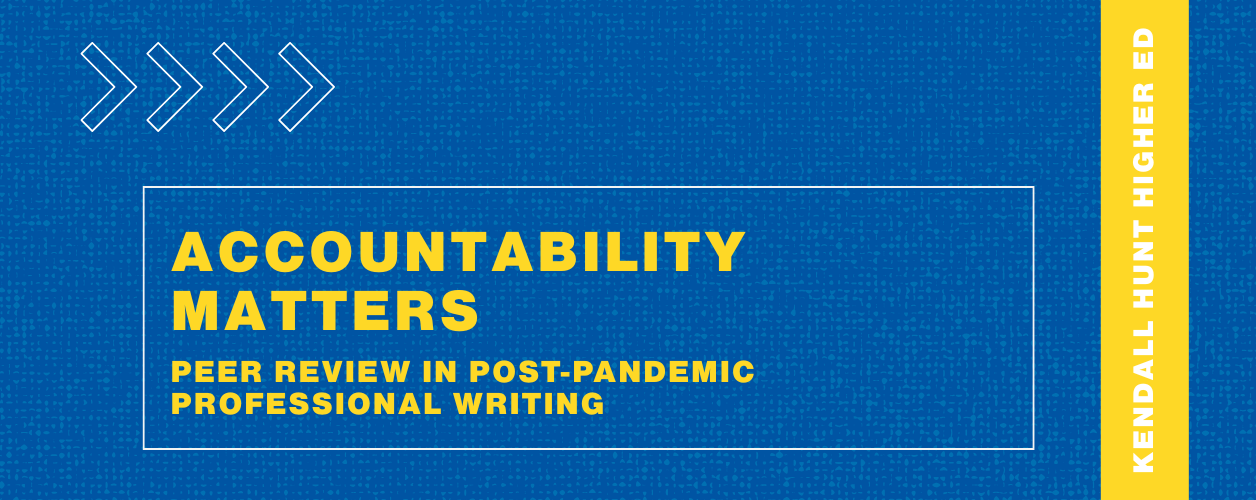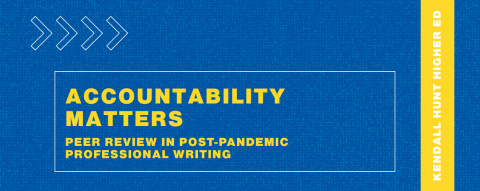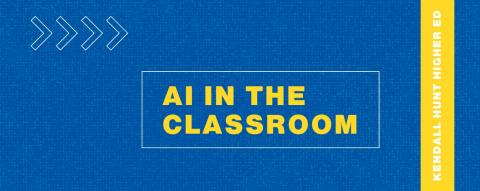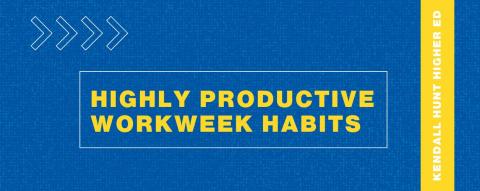
Accountability Matters: Peer Review in Post-pandemic Professional Writing
For the past number of years, the focus of educational research has shifted away from “excellence” and toward “equality,” in order for the highest levels of achievement to be attained by the largest number of students. What we did not expect, however, is the contrast between “excellence” and “equality” to be as drastic as it was revealed to be once the education system, at all levels, was suddenly thrust into a global pandemic. Our mass movement into “emergency remote education” due to COVID-19 surely taught educators what did not work well. However, in hindsight, it also taught us a number of strategies that worked particularly well, which we could not have learned in any other way. These contemporary understandings are rooted in fundamental ideas I identified almost a decade ago when I began experimenting with the online writing classroom in the undergraduate setting.
While peer review has always been an essential component of professional writing instruction, the process remained relatively stagnant until the COVID-era forced us to consider how it could be presented in a way that is logistically feasible, while concordantly adhering to the enterprise’s intended goals. Even though my home institution, Rutgers, The State University of New Jersey, had Learning Management System (LMS) access since 2008, there had always been a sharp division between the use of our LMS and the administration of in-class activities. It wasn’t until I began to experiment with online teaching and tutoring did I begin to realize that a blended modality is a necessity in professional writing courses. These suspicions were confirmed as I commenced in adapting my courses to novel realities of the COVID-era.
The Fundamental Relationship Between Peer Review and Public Spaces
While, at Rutgers, we had been offering a limited number of fully online sections of professional writing for a full decade before we all moved “online” to some extent in 2020, peer review was one of those activities, while fundamental to our students’ writing experience, always eluded us in terms of administration within virtual spaces. The lack of clarity in this regard was rooted, I discovered, in our expectations concerning the appearance of privacy in the classroom. Regardless of what taking place in our classrooms in terms of an increasing use of technology, peer review always remained, for lack of a better term, “old-school.” Students would bring in physical copies of their documents, I would assign random groups of four, and based upon the criteria delineated for the particular project, as reflected by a respective peer review form, the students would critique each other’s materials to assist them through the revision process.
In my early experiments with online learning, while I was gradually bringing instructional materials into the virtual world, the process of peer review remained virtually identical. The only difference was that papers were emailed to group partners, as opposed to being physically distributed. At the time, we saw this as superior to the face-to-face classroom experience in that there was an appearance of anonymity, in line with the prevailing research supporting the potentially equalizing aspects of the virtual setting in terms of perceived biases about age, gender, race, and ethnicity.
Our Pandemic-related Collective Foray into Online Learning
As we discovered through the COVID-era, in terms of professional writing pedagogy, the previously eluded public aspects of peer review could be emphasized through inventive uses of the LMS’s “discussion” forum, yielding benefits to all students engaged in the process. As a result, upon returning to the classroom setting in the post-pandemic environment, my professional writing classes evolved to apply the unexpected advantages of the virtual setting, in which peer review had to be conducted exclusively online. Once we returned to the face-to-face environment, my students and I commenced in bringing the best of both worlds into our classroom. Prior to the session in which we were due to conduct peer review for a given assignment, as opposed to bringing in a physical paper, each student in the class took on the responsibility of posting their respective documents to a Canvas “discussion” forum reserved for the project before the start time of our class. Once they arrived to class, the students were divided, as usual, into random groups of four, through the “student groups” feature of the LMS, upon which the students would locate their partners’ documents uploaded to the forum. Each student would then read, and respond to, the respective materials, in light of a peer review form downloaded from our LMS, and subsequently post their responses as a thread under their partners’ names.
Not only were the assignments accessible to each student’s assigned partners under this new protocol, but they were also accessible to every student in the course. In turn, the instructor was able to monitor the entire process, in terms of both document uploads and posted responses, through a series of time stamps, as the discussion forum’s branches grew throughout the class session. Time was reserved at the end of the process for students to question and/or clarify any elements of the assignment or the critique received. Ample time was reserved for questions posed to the instructor, as well.
Achievement in my professional writing courses has been markedly higher since this blended peer review process had been implemented. Students are preparing stronger drafts in advance, peer review is more rigorous on both sides of the assignment, and final products have been exceptionally strong, polished, and professional. In addition, due to the public nature of the exercise, both the quality of early drafts and the reviews provided are more carefully considered and beneficial to the writers and readers. Since documents are shared in advance and online, a student does not need to be in the classroom to participate in peer review. This allows for participation of students who may not be able to attend due to illness, as well as ensure that a missed class does not hinder assignment workshopping.
The Relevance of the Six-P’s in Preparing Students for Rigorous Peer Review
My textbooks, Business and Professional Writing: From Problem to Proposal and Scientific and Technical Writing: From Problem to Proposal, align with the guiding philosophy of the professional writing courses at Rutgers – that students learn how to write in the business and technical fields through ownership of their ideas. While each student bears the ultimate responsibility for the level of success of their respective project, this is in no way a solitary effort. As the course instructor, it is my responsibility to make my students aware of the communities at work within any academic discipline in which they are engaged and that these populations are an inescapable part of the research and writing processes. Their acknowledgement and investigation of these related populations provides my students with the perspective needed to develop strong, viable, and realistic workplace projects. My students are consistently engaged with each other’s projects, with peer review occurring regularly throughout the semester for each assignment. The respective assignment criteria, upon which peer review is based, are designed in a way in which the students, as well as the instructor, can judge the merits of a given project through the lens of the prospective audience the writer has identified through significant research.
In line with this learner-centered philosophy, these texts are designed to assist students in building a proposal, in a very real way, from the ground up. Through multiple phases of drafting, review, and revision, among a series of sequential documents, my students put this philosophy into practice very early in the writing process and carry it with them throughout the rest of the course. For each consecutive document, leading up to the capstone assignment, the project proposal, this process assists each student in collating, organizing, and interpreting the information accumulated up to a given point and, more importantly, where they need to go next in their research.
The development of my students’ proposals is based on a heuristic we constructed, known as the Six P’s, which serves to guide the structure of my texts and, in turn, my courses. The sequence of the Six P’s matches the order in which they will appear in their final project proposal. The first P, patron, refers to the intended funding source for the proposal. The second P, population, indicates the potential beneficiaries of the proposal. The third P, problem, is the issue that needs to be addressed. The fourth P, known as paradigm, is the researched justification for the plan of action. The fifth P, plan, is the delineated plan of action. Finally, the sixth P, price, represents the final budget for the fully developed plan.
Looking Ahead to Opportunities for Peer Review in the Professional Writing Classroom
One of the major hurdles that students face in my professional writing courses is striking a balance between originality and working with existing paradigms. Frequently, they will ask, “where is the room for creativity and ingenuity if everything needs to be supported by research into what other people have done?” In responding to this question, and concurrently assist these students in developing project proposals that are both original and rooted in research, my texts look to Thomas Kuhn’s discussion of paradigms in his seminal 1962 work, The Structure of Scientific Revolutions. As Kuhn tells us, “the productive scientist must be a traditionalist who enjoys playing intricate games by pre-established rules in order to be a successful innovator who discovers new rules and new pieces with which to play them” (146). In this way, we train our professional writing students to be conscientious researchers so that they are able to apply paradigms from their various related fields of study in unique and inventive ways.
Rigorous peer review is a foundational principle of the professional writing enterprise. If professional writing classes are producing authentic workplace documents, as they purport to do, guided critique followed by rigorous revision must be part of the writing process. In addition, for peer review to be effective, there must be rigor on both sides of the review criteria. The reviewer needs to be conscientious about the constructive criticism they are providing. In turn, the student receiving the critique must be certain that it can be used effectively as they embark upon the revision process. In this way, both students are provided with the requisite tools to walk away from the peer review experience with a knowledge of how to work within the given assignment framework with a high level of expertise. As I learned out of pure necessity within the “emergency remote” context of 2020, into the hybrid environment that immediately followed, and through the post-pandemic phase in which we currently find ourselves, the most effective way to achieve our goals as writers in the professions is one that is firmly situated within the virtual public sphere, within the traditional classroom setting.



